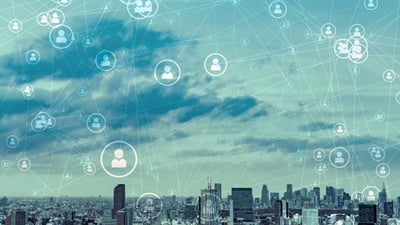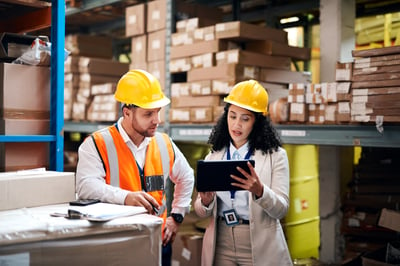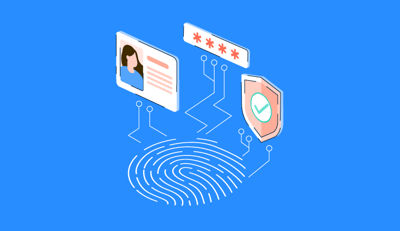January 18, 2018
 by Kara Sargent / January 18, 2018
by Kara Sargent / January 18, 2018

A digital twin is an exact digital replica of a product, process or service. This living model creates a thread between the physical and digital world.
Internet of things (IoT)-connected objects are replicated digitally, enabling simulations, testing, modeling and monitoring based on the data collected by IoT sensors. Like everything in the realm of IoT, data is the primary driver, and most invaluable output, of digital twins. The sharing and analysis of digital twin data empowers companies to make decisions which directly impact their key performance indicators.
It’s important to not confuse the concept of digital twins with the popular act of digitization (that is, making something physical digital for ease of access, portability, security, etc.). An example of digitization would be scanning old photos to save in the cloud. Once scanned and digitized, the need for the original physical version of the pictures goes away.
A digital twin, alternately, does not act as a replacement for the physical object or service which it represents. Instead, it is a digital replica of the initial “thing,” acting as a vehicle for monitoring and testing around the physical object without actually having to be in close proximity to it.
Sensors attached to the physical object collect massive amounts of data, which allows the digital version to act like the physical object. This shows a business exactly how each individual machine on their production floor is functioning, for example, rather than making assumptions based on a generalized expectation for how the machine should function, when it will need repairs or how it could perform more efficiently.
The idea of digital twins is predated by pairing technology, developed by NASA to help in the operation, repairs and maintenance of spacecraft traveling outside the range of physical monitoring. These “twin” systems are what made it possible for engineers and astronauts to test repairs for the ill-fated Apollo 13 mission, bringing the craft and crew back to earth safely. NASA now uses digital twins, thanks to the development of sensors, to gather data, make recommendations to crew members and plan for the needs of future aircraft. Aside from maintenance, digital twins can also be used to improve and evolve customer experience.
In an interview with Forbes, John Vickers, NASA’s leading manufacturing expert and manager of NASA’s National Center for Advanced Manufacturing, said, “the ultimate vision for the digital twin is to create, test and build our equipment in a virtual environment. Only when we get it to where it performs to our requirements do we physically manufacture it. We then want that physical build to tie back to its digital twin through sensors so that the digital twin contains all the information that we could have by inspecting the physical build.”
When a company deploys a digital twin, there needs to be intent to not only gather information, but to also take that data and use it to drive specific business outcomes. Digital twins provide much more than visibility into how remotely-located equipment is functioning. The data collected from digital twins, and the value that digital twins provide, can and should be used to evolve how the business functions.
Gartner predicts that by 2021, 50 percent of large industrial companies will use digital twins, resulting in those organization gaining a 10 percent improvement in effectiveness. Companies looking to stay ahead of their competitors, especially in the manufacturing and engineering industries, need to consider the implementation of digital twins now if they want to stay ahead of the competition.
At the most basic level, digital twins give organizations visibility and insight into the operation of their machines in the context of the environment or IoT ecosystem they’re a part of. The data gathered from sensors empowers businesses to have the parts or staff on hand before problems become problems. This data is especially powerful — companies can use the data collected to be predictive, adapting business processes to be smarter in the future. The one-to-one nature of digital twins is extremely valuable. By understanding an actual individual machine, as opposed to having to make generalizations based off of industry expectations, removes some of the ambiguity around a machine’s operations.
Modeling and analysis are especially valuable outcomes of employing digital twins. Subject matter experts are able to test scenarios, changes or updates, asking what-if questions to simulate conditions that could arise but wouldn’t be realistic to attempt in real life. All testing is done on the digital twin first, giving enterprises the flexibility to walk through multiple scenarios prior to making a decision that could impact business processes, operations and employees. The adaptability that this can provide a company to innovate and evolve without disrupting day-to-day operations is invaluable.
Decreasing costs in IoT technologies and sensors, and the networks which support them, have also led to a decrease in cost for digital twins. Once digital twins are developed, they have the potential to save a business money and employee time. The resources that can be saved by reducing downtime and lowering maintenance costs is incredibly valuable to an organization over time. A Vanson Bourne study found that 82 percent of surveyed companies in the fields of manufacturing, medical, oil and gas, energy and utilities, telecoms, distribution, logistics and transport had experienced at least one downtime outage in the past three years, with the average company having experienced two. Additional research in the study showed that the average cost of downtime in these fields is $250,000 per hour.
To keep up with digital twins, companies will need to ensure that their workforces are evolving. Digital twin modeling and support requires massive and continuous data collection and organization. Algorithms need to be developed and maintained to manage and utilize that data. Software will need to be updated frequently, and systems will need to be heavily monitored. Companies will need to consider hiring more data analysts and technically-focused operators who have familiarity with data models to help support the digital twins and drive business change in an informed way.
Digital twin technology has implications across a wide variety of industries: From an HVAC technician visualizing and predicting maintenance on the fan motor of an industrial cooling unit, to a manufacturer testing the impact of introducing a new packaging machine into its shipping processes prior to actually implementing the machine in real life, digital twins enable businesses to conduct tests, and make smarter and better-informed decisions in the digital world before implementing them in the physical. The technology has predominantly been adopted in manufacturing, but it has implications across a number of industries, some of which I’ve given examples for below.
Digital twins can revolutionize both hospital operations and the care provided to patients. Creating an interconnected system of digital twins that represents an entire hospital and all of the machinery therein can help operations teams create a safe environment with expedited patient care. Companies have also been testing making digital twins of humans and organs so they can be fully studied, and procedures can be simulated and tested prior to being done on the actual person. This has the potential to decrease mortality rates and improve patient outcomes.
GE engineers are working to build bandage-sized sensors that could monitor a person’s vital information such as heart rate, blood pressure and oxygen levels. All of that medical data would then be gathered and connected to a digital twin created from an exact model of the person’s body. Medical information could then be analyzed by software, which in turn would alert doctors to anomalies. With artificial intelligence integration the software could even begin to make diagnostic recommendations. This could improve care in hospitals, but also give physicians visibility into their patients’ wellbeing when they are not at the hospital.
Manufacturing is the industry in which digital twins are most commonly used today. Producing quality products on time to expectant customers is critical for any manufacturer, and if their machines are not working in unison and at their appropriate capacity, it can impact the employees, production, deliverability and, ultimately, customer satisfaction with the company. By enabling manufacturers to monitor performance in real time to inform processes and test efficiency updates without interrupting normal workflows, digital twins make manufacturers smarter and more informed by the millions of data points collected throughout their facilities.
In a case study presented by Deloitte, an industrial manufacturer decided to deploy a digital twin approach to address issues it was having in the field which led to maintenance expenses and delayed deliverability for customers. The manufacturer gathered data on its machinery as well as the products being created, which led it to be able to hone in on assembly processes and their relation to product quality. As a result, the team was able to recognize inefficiencies and optimize the assembly process, reducing rework by 15 to 20 percent.
It’s predicted that by 2020 there will be 10 million self-driving cars on the road. The emergence of autonomous vehicles means a proliferation of new, interconnected things. Automotive manufacturers can create a digital twin of every single autonomous vehicle it sells, enabling them to analyze how a car performs in its physical environment, and track the vehicle from creation to the day it goes to the junkyard. Much of the sensor infrastructure is already in place in newly released vehicles that are constantly controlling a car’s critical systems. When you go to the auto shop and a mechanic runs diagnostics, it is this sensor data that tells them what needs to be repaired. The next step is setting up systems for that data to automatically be transmitted back to the manufacturer, analyzing that data and performing predictive analysis that can help make driving experiences smarter and safer for car owners.
These are only a few examples of industries where digital twins are helping with digital transformation, but the potential is wide-reaching. Especially in manufacturing and engineering spaces, if your company is not evaluating the benefits that digital twins can provide, you may be making a costly decision that could put your years behind your competitors.
Kara is Director, Market Research at G2. She is passionate about understanding people's business problems and educating software buyers to make informed purchasing decisions. Kara builds meaningful relationships with vendors and providers to ensure end users understand the solutions available to them. She has spent the last five plus years building G2's market research team and is dedicated to developing industry-leading taxonomies and resources.
In today's modern business environment, advancing technology has continually reshaped the way...
 by Andrej Kovačević
by Andrej Kovačević
Have you ever stopped to think about the profound changes people-centric technology is...
 by Eric Whitley
by Eric Whitley
In today's modern business environment, advancing technology has continually reshaped the way...
 by Andrej Kovačević
by Andrej Kovačević
Have you ever stopped to think about the profound changes people-centric technology is...
 by Eric Whitley
by Eric Whitley



